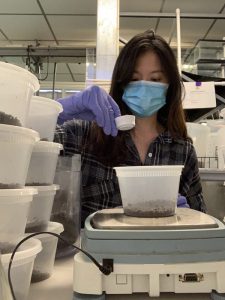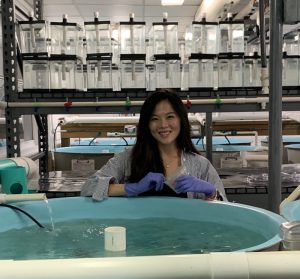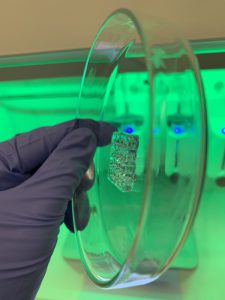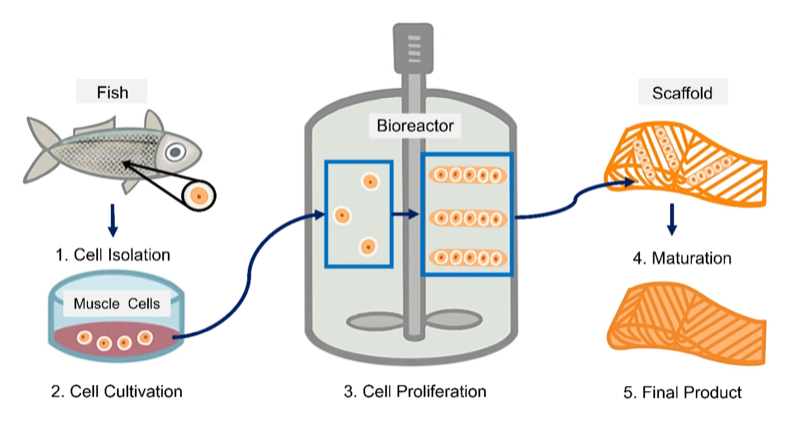 Welcome back to FSHN Research Journeys, which follows the research of graduate students in the Food Science and Human Nutrition program at The University of Florida. Today’s guest poster is Sharon Chuah, a first-year student working toward her Ph.D. in food science. Under the mentorship of Dr. Razieh Farzad, Sharon is exploring the use of cellular agriculture to meet the growing demand for seafood. Read on to learn about how she discovered her passion for food science, cemented her commitment to sustainable seafood production, and used 3D printing in her project.
Welcome back to FSHN Research Journeys, which follows the research of graduate students in the Food Science and Human Nutrition program at The University of Florida. Today’s guest poster is Sharon Chuah, a first-year student working toward her Ph.D. in food science. Under the mentorship of Dr. Razieh Farzad, Sharon is exploring the use of cellular agriculture to meet the growing demand for seafood. Read on to learn about how she discovered her passion for food science, cemented her commitment to sustainable seafood production, and used 3D printing in her project.
Sharon: With the growing human population, consumer demand for seafood is increasing while the current production rate of capture fisheries and aquaculture cannot keep up.1 Soon, there will be a substantial gap between the supply and demand of seafood.2 Therefore cellular agriculture, the production of seafood from cells such as muscle and fat cells using cell culture techniques, has been proposed as a novel approach to complement the conventional seafood industry.3,4
The Difficulty of Feeding a Growing Population

Feeding the world in the backdrop of a growing human population, climate change, and competition for natural resources is a key challenge for our global food system.5 Worldwide, seafood accounts for nearly 20% of the annual global animal protein consumption.1 The United Nations Food and Agriculture Organization (FAO) projects an increase in per capita seafood consumption globally of 18% by 2030.1 This increase will be a great challenge for the seafood industry from a production standpoint.
Conventional seafood production systems are facing many challenges. For example, overfishing has resulted in a 39% decrease in the number of marine species over the past 40 years. Furthermore, 30% of the fish stock is commercially overfished and 60% of the fish stock is fully fished.1
Cellular agriculture is an emerging food production system that could potentially revolutionize sustainable seafood production. This technique could significantly relieve the pressure on our oceans. Cellular agriculture could also address the problem of seafood toxicity by producing mercury-free cell-based seafood as an alternative protein source for vulnerable populations such as pregnant people and children.

Sharon Discovers Her Passion for Food Science
In 2021, I graduated from North Carolina State University with an M.S. in Poultry Science under the guidance of Dr. Adam Fahrenholz. My research focused on the impact of moisture on the physical and chemical variables in pelleting processing. In this journey, I realized I have a lot of passion for food science. To me, food science is so fascinating because it is the applied material science in daily life.
After exploring different food science research opportunities, I was intrigued and inspired by Dr. Razieh Farzad’s passion and research on cellular agriculture. I’m thrilled to be part of a research team answering one of the most pressing questions about our global food systems: how will we feed our growing population? I believe cellular agriculture has the potential to revolutionize our food production system.
Feeding a Growing Population for the Long Haul

Cellular agriculture is an alternative protein production system using animal cells obtained through biopsy without harming or killing the animal. The cells are cultured in a cell culture media and later in a bioreactor to produce cells on a large scale.8 The challenge is to scale up the production of cell-based protein while keeping prices low and maintaining the sensory characteristics that define conventional animal protein.
Research on creating different types of cell-based proteins has focused primarily on mammalian cellular production.4 Even though little research has been done on fish tissues, researchers have found that fish muscle cells may be more adaptable to in-vitro cultivation compared to mammalian cells.4 Fish cells have better doubling ability and can be cultured in atmospheric air. However, the availability of fish cell lines appropriate for cell-based seafood production is still limited.
If we could create lab-grown fish, this system will be an alternative seafood source for humans. We would no longer depend on the traditional seafood production system, relieving pressure on the current supply.

How Cellular Agriculture and 3D Printing Can Create a Superior Product
For my research, I will investigate the properties and ideal culturing conditions for white fish cell lines. The structure of cell-based lean fish is less complex to produce due to its low-fat content (1-2%).9 Interestingly, it is also easier to recreate a full white fish sensory experience than red fish due to its simpler flavor profile.1 Therefore, it is more efficient to cultivate white fish cells.
The problem with cell-cultured fish is that it is nearly impossible to mimic the texture and marbling of fish by just incubating fish cells. Therefore, I will be researching ways to create 3D structures, also known as tissue scaffolds, that will encourage cell growth that imitates the texture of fish. To do so, I will use state-of-the-art 3D printing techniques. My goal is to create cell-cultured fish fillets with a comparable structure to their traditional counterparts. The tissue scaffolds will be made from edible and biocompatible materials (e.g.., chitin, alginate, and cellulose) to ensure the safety of the final products.

I am currently working on a review paper focusing on the strengths, weaknesses, opportunities, and threats (SWOT) of culturing different fish cell sources. On top of that, I am researching consumers’ willingness to pay (WTP), as well as their acceptance of cell-based seafood products, since consumers have the greatest influence on the marketability and success of cellular agriculture.11 Although cellular seafood production is still in its infancy, I hope it will soon serve as a solution to the gap between seafood supply and demand while relieving the burden on the ocean ecosystem.
Sharon Chuah was born and raised in Penang, Malaysia. She graduated from North Carolina State University with a B.S. and M.S. in Poultry Science. She is currently pursuing a Ph.D. in Food Science from the UF/IFAS FSHN department under the mentorship of Dr. Razieh Farzad. Sharon is a big coffee lover and sourdough baker. When she retires, she wants to open an artisan coffee shop and use the profits to support women’s education.

References
- FAO. The State of World Fisheries and Aquaculture 2020. In brief. The State of World Fisheries and Aquaculture 2020. In brief (FAO, 2020). doi:10.4060/ca9231en.
- J., F. Aquaculture chickens, salmon: a case study. World Aquaculture Magazine (1999).
- Sharma, S., Thind, S. S. & Kaur, A. In vitro meat production system: why and how? Journal of Food Science and Technology vol. 52 7599–7607 (2015).
- Rubio, N., Datar, I., Stachura, D., Kaplan, D. & Krueger, K. Cell-Based Fish: A Novel Approach to Seafood Production and an Opportunity for Cellular Agriculture. Front. Sustain. Food Syst. 0, 43 (2019).
- Merino, G. et al. Can marine fisheries and aquaculture meet fish demand from a growing human population in a changing climate? Glob. Environ. Chang. 22, 795–806 (2012).
- Fiala, N. Meeting the demand: An estimation of potential future greenhouse gas emissions from meat production. Ecol. Econ. 67, 412–419 (2008).
- Häder, D.-P. Effects of Pollution on Fish. in Anthropogenic Pollution of Aquatic Ecosystems 39–60 (Springer, Cham, 2021). doi:10.1007/978-3-030-75602-4_3.
- Reiss, J., Robertson, S. & Suzuki, M. Cell sources for cultivated meat: Applications and considerations throughout the production workflow. International Journal of Molecular Sciences vol. 22 7513 (2021).
- Potter, G. et al. A More Open Approach Is Needed to Develop Cell-Based Fish Technology: It Starts with Zebrafish. One Earth vol. 3 54–64 (2020).
- Mansur, M. A., Bhadra, A., Takamura, H. & Matoba, T. Volatile flavor compounds of some sea fish and prawn species. Fish. Sci. 69, 864–866 (2003).
- Halpern, B. S. et al. The long and narrow path for novel cell-based seafood to reduce fishing pressure for marine ecosystem recovery. Fish Fish. 22, 652–664 (2021).
Looking for more posts exploring graduate research projects in the Food Science and Human Nutrition Department at the University of Florida?
Dive into the Research Journeys of other graduate students below.
M.S. Food Science
M.S. Nutritional Sciences
Ph.D. Food Science
Ph.D. Nutritional Sciences
 8
8
